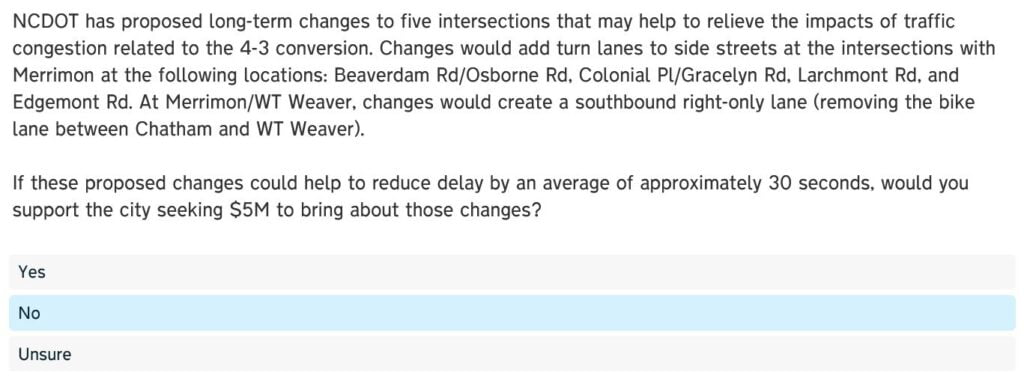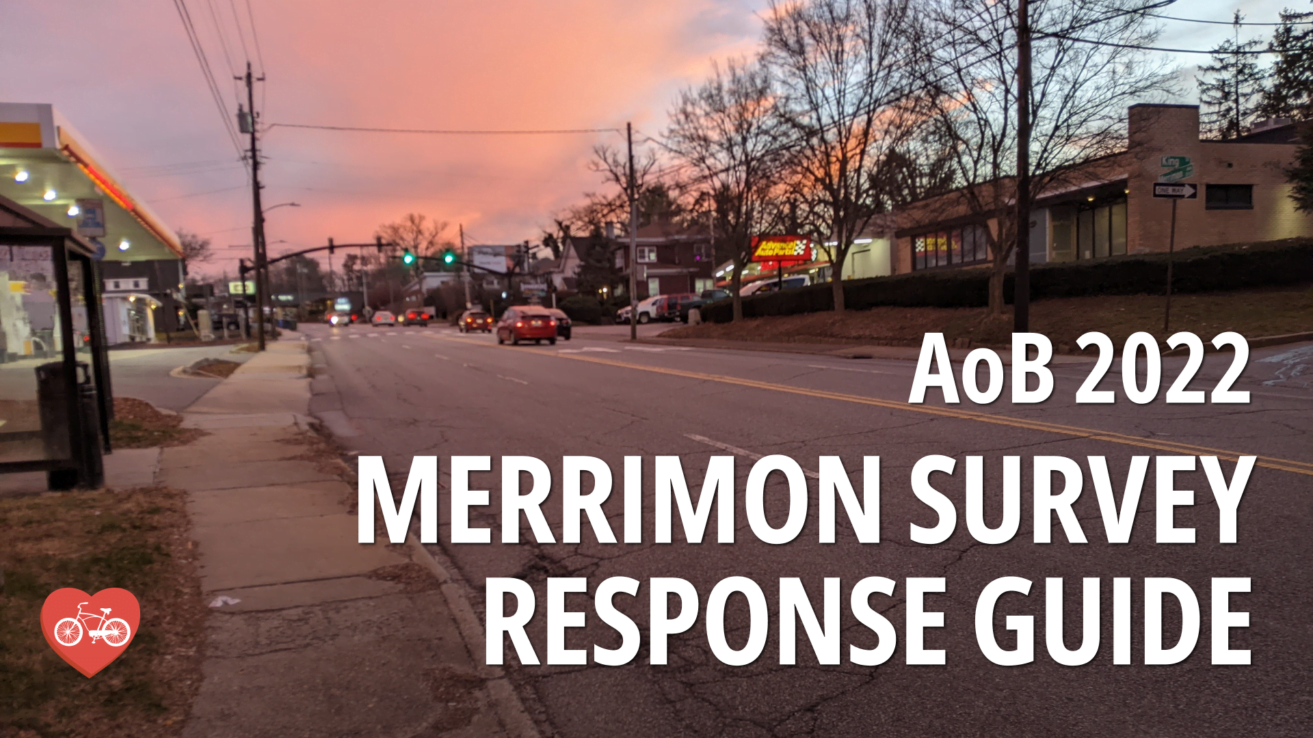
The City of Asheville in partnership with North Carolina Department of Transportation (NCDOT) have published a Story Map and public survey to collect input about the proposed 4-3 conversion for Merrimon.
AoB endorses the proposed 4 – 3 conversion and encourages you to take the survey and show your support.
Take the survey:
The Merrimon survey is here. It is open until March 22nd.
Follow AoB’s survey guidance to maximize your support.
The City also has an explanation of the project here: https://publicinput.com/Merrimon-Asheville and a map that allows you to see traffic and collision data for the corridor. That Storymap is here.
If you are looking for our 33 page study of the proposal, that’s here. And our up-to-date resource page tracking the proposal is here.
Question 1:
Answer based on when you use Merrimon:

Question 2:
Before answering this question, consider how often you cross over Merrimon on your bicycle or by walking. If you primarily bike within Asheville, and cross over Merrimon, then you are one of the primary bicycle users who ride on Merrimon. If you can, use this opportunity to demonstrate that people on bikes and walking do, indeed, use this street.
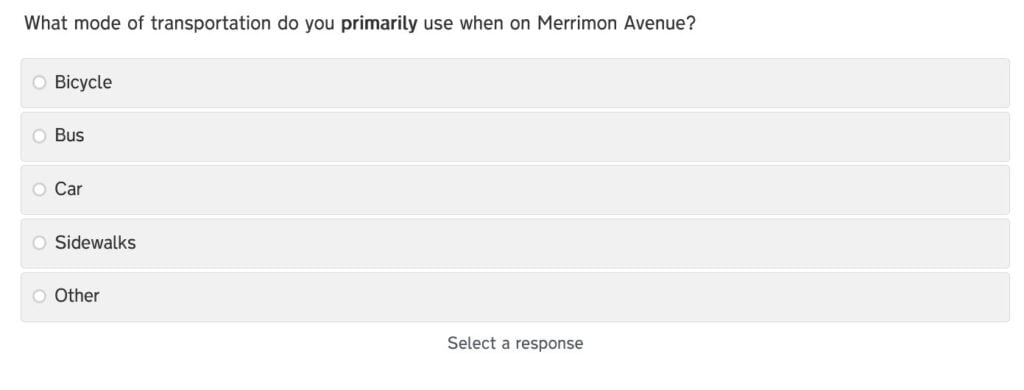
Question 3:
Make sure that “I visit shops, businesses, and / or dining establishments on Merrimon” is included in one of your top three answers. It’s important that decision makers understand Merrimon as a robust commercial zone that connects people to goods and services. One of the main benefits of this conversion is to improve the connections between local residents and businesses on the corridor.
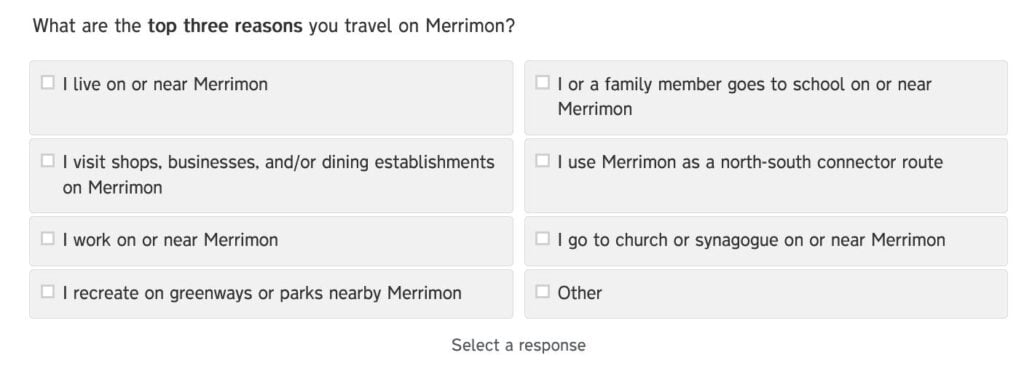
Question 4:
Be sure to rank “Safety,” as the most important consideration and then rank “Other” as the second most important consideration. Often bicycle and pedestrian facilities aren’t included in NCDOT priorities and they have been left off this list entirely, so it’s up to you to make the extra step to include them as “Other.” Put “Speed” in last place as the least important consideration.
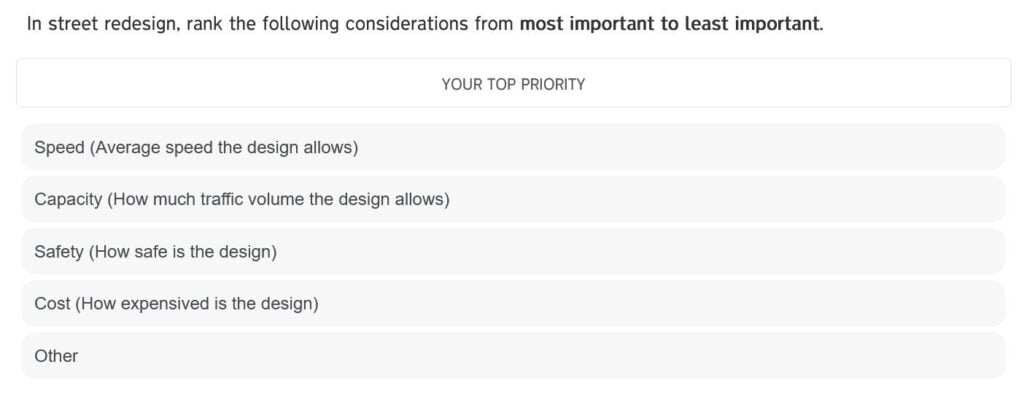
Question 5:
Zero bicycle facilities and unpredictable traffic movements make Merrimon an inhospitable place for people on bikes. Slide to “Unsafe.”

Question 6:
Independent of any timing or bus line problems, bus riders are harmed by the lacks of adequate or ADA compliant sidewalks, since all transit users are sidewalk users. Additionally, some of the bus stop locations encourage people to wait inches from traffic or to sprint across the roadway to reach the correct bus stop for the bus they need to take. Slide all the way to “Unsafe.”

Question 7: Cars.
The City of Asheville’s Story Board states, “Over the last 10 years, this 2.5 mile section of Merrimon has seen more than the expected number of roadway crashes. Data shows that there is approximately a 150% higher rate of crashes on Merrimon compared to other similar roadways across the State (for every 10 crashes on other similar roads, Merrimon gets 15)…Approximately 23% of crashes on Merrimon involve an injury and property damage estimates total more than $7 million.” You can listen to a first hand account of one of these collisions here.
Slide it all the way to unsafe.

Question 8. Sidewalks.
The existing sidewalks are incomplete, inadequate, and far from ADA compliant. Although sidewalk improvements are outside the scope of this road reconfiguration project, it’s important to document how dangerous and unreliable the active transportation facilities are. Slide all the way to “Unsafe.”

Question 9. Top three challenges?
The top three challenges to using Merrimon Ave are: 1) Vehicles making left turns block the travel lane, 2) There are no bike lanes, 3) Sidewalks are in poor conditions and/or difficult to use.
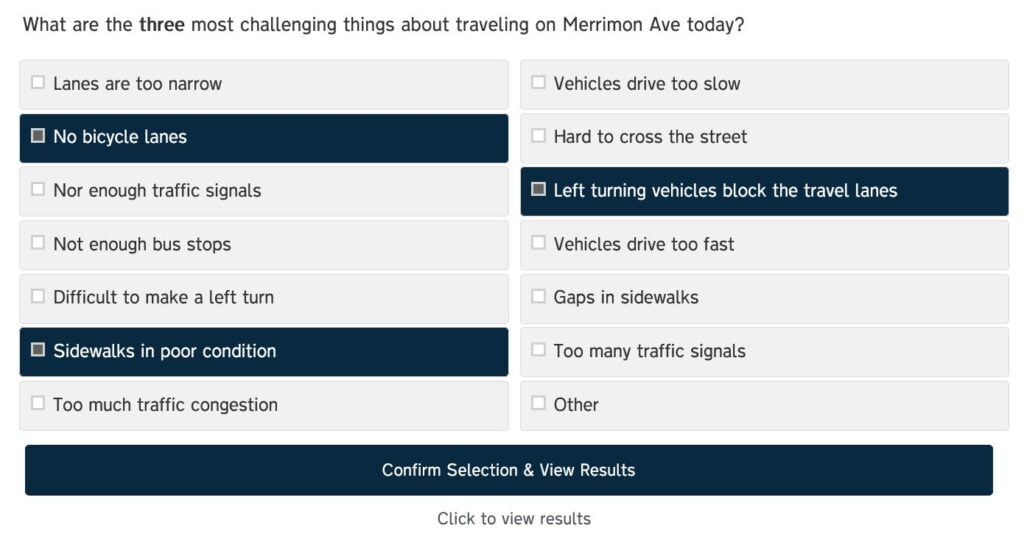
Question 10 & 11. Would you accept greater rush hour travel time?
The following questions are questions of values. This is really the crux of the decision to move forward with a road reconfiguration. NCDOT’s analysis claims that travel times could be increased during peak times, between 1 min to 2 min. Are you willing to spend more time on Merrimon for a 29% decrease in collisions? Essentially, are you for a safer street or a collision prone street?
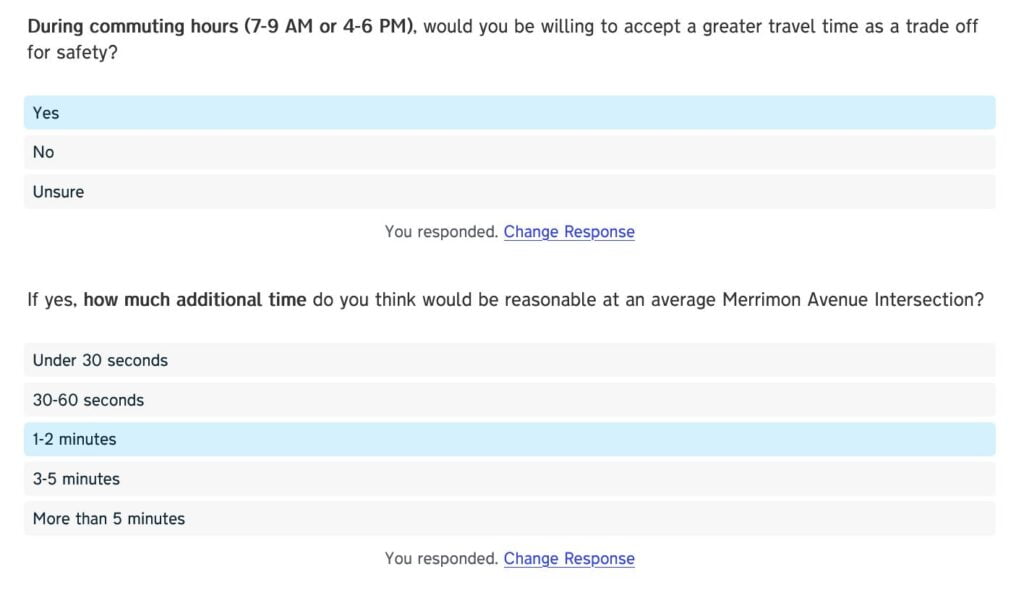
1 to 2 minutes during peak times is an acceptable trade off for a 29% reduction in collisions. Can you imagine an airline company asking customers, “Do you value a faster plane or a safer plane?” Faster travel times should not be an important design goal on a road as dangerous as Merrimon.
Question 12. Would you change your commute?
It’s easy to forget that there are other North-South connections and that some people can change their commuter times – not all, but some. Also, according to NCDOT’s analysis, traffic volumes on Merrimon haven’t changed significantly for 20 years and stay in a range of about 20,000 cars/day.

Choose “Yes” and indicate which type of change you would consider if you knew that your route was congested.

Use “other” to draw attention to the significant growth in remote work, a change that increasingly looks permanent for a large portion of the U.S. workforce.
Question 13. How likely are you to change modes?
This question is about mode share. This is important because NCDOT’s traffic models do not account well for mode share changes over time. Traffic projections, wait times, and estimates of queuing at lights along Merrimon all assume that people will drive because that’s what we have done in the past. If Merrimon changed to 3 lanes, had a slower, calmer traffic pattern, was easier to cross as a pedestrian, and had a bike lane, what other modes would you consider using?
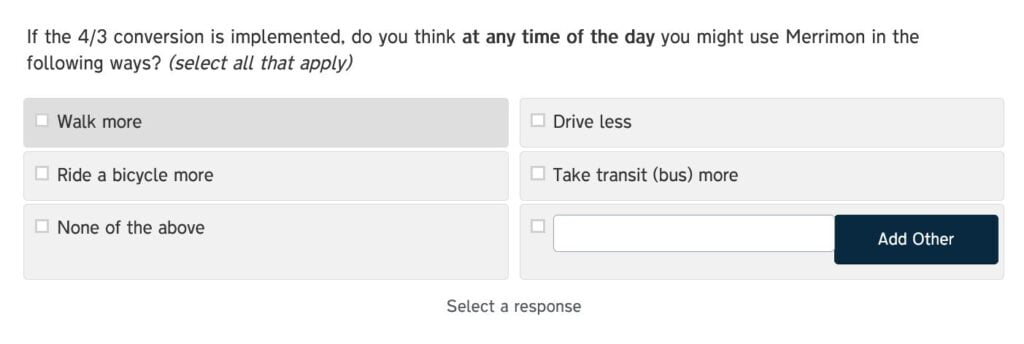
You can use “other” to list things like wheel chairs, e-bikes, e-scooters, One Wheels, e-cargo bikes. A new ebike sold every 52 seconds in the U.S. in 2020 and sales continue to climb.
Question 14. What other transportation improvements?
Generally, AoB discourages copy and paste answers but this time it’s just too important to miss the opportunity to encourage NCDOT to explore and consider signalization changes along the corridor. Oftentimes, simple adjustments in traffic signals maximizes the efficiency of a corridor. We need to remind NCDOT that signalization upgrades are an option. Similarly, if the road diet works north of W.T. Weaver, it is also likely to work north of Chestnut. Ask them to expand the portion of the road included in the 4-3 conversion.
Copy and paste this statement into the survey:
The 4 to 3 conversion should be expanded and begin at the intersection of Chestnut and Merrimon. Install loop detectors on all lanes at all intersections so motorists don’t wait for unneeded light cycles. Install loop detectors and push button detectors for bicyclists facing bike lanes to optimize traffic flow. Follow AASHTO’s “Guide for the Planning, Design, and Operation of Pedestrian Facilities” which says “Pedestrians must be able to cross streets and highways at regular intervals. Unlike motor vehicles, pedestrians cannot be expected to go a quarter mile or more out of their way to take advantage of a controlled intersection” (30).

Question 15 and 16. Help or hurt businesses?
The research overwhelmingly supports that when active transportation access improves, there is a positive economic impact on the corridor.

This is an excellent opportunity to cite NCDOT’s past work so that our local engineers may be informed by their own agency’s case studies regarding Complete Street treatments and road re-configurations. There are several examples of 4 to 3 conversions throughout NC that improved safety, improved multimodal access, and result in positive economic impacts along the improved corridors.

If you want to point to another 4-3 conversion that works, copy and paste any of the following:
- The West Morehead Streetscape Project in Charlotte, NC is listed as a 3 lane conversion on NCDOT’s Complete Streets website. It states, “Complete Streets features have been key to revitalizing this commercial corridor. Now, after the Streetscape Project, West Morehead serves as a gateway into the City. The project improved the quality of life for pedestrians, and economic development has boomed as well.” – Project Manager Leslie Bing
- East Boulevard Road Diet Project in Charlotte, NC saw crashes decrease and tax revenues increase. “Overall, crashes decreased in both sections, from 2.64 to 1.67 crashes per month in Phase 1 and 1.97 to 1.86 crashes per month in Phase 2. Improvements in safety have gone hand-in-hand with a 47% increase in non-residential property values in the Phase 2 section, which raised annual tax revenues by $530,000.”
- Hillsborough Street in Raliegh, NC installed a 4-3 conversion on a traffic volume of 26,000 cars per day. It worked and private investment in the corridor went up from $150m to $200m after the project. “Revitalizing the community was more important than the street improvements,” he says. “The street just became the focal point of how to get it done.” Collisions decreased by 23% after the install while also revitalizing the community.
If you want to tell your own story, tell a story of how your travel patterns on the future corridor can make existing businesses more money while we all experience the safety benefits of this change. For example:
- I look forward to walking from my house in Norwood Park to Zen Sushi and The Hop.
- I’m tired of white knuckled driving with my head on a swivel every time need to go to the drug store. I know Merrimon is dangerous and I want it to be safer – even for cars.
- I look forward to riding to ACE Hardware on my e-bike to pick up a few screws for my next project
- My daughter wants to ride her bike to the comic book shop but I won’t let her. Maybe I will if this conversion happens.
- I’m tired of running for my life when I park across the street from Vinnie’s Italian. I shouldn’t have to risk my life to eat Italian food.
- I rarely walk to any business on the other side of Merrimon from my neighborhood – it’s like those businesses are missing half their customers now, the ones from the other side!
- I want to take my kids to school at Ira B. Jones on an electric cargo bike (skip the car line!) but I cannot get their safely on any direct route, since I live on the west side of Merrimon.
Question 17: Support the 4-3 conversion?

Question 18: Widen Side Streets?
We don’t think these changes should be planned in advance, without demonstrated need, for each of these intersections. You should select “No.” The issue highlighted here is that if each intersection on Merrimon is cycling through a new left turn cycle, made possible by the new center turn lane, then each intersection would take longer to cycle through all phases than it does today, allowing a longer line of cars to arrive and line up on side streets, facing the intersection. It is important for NCDOT to make sure signalization is tuned after installation of the project and to install loop detectors on all lanes at each intersection for the same reason, to minimize wait times.
